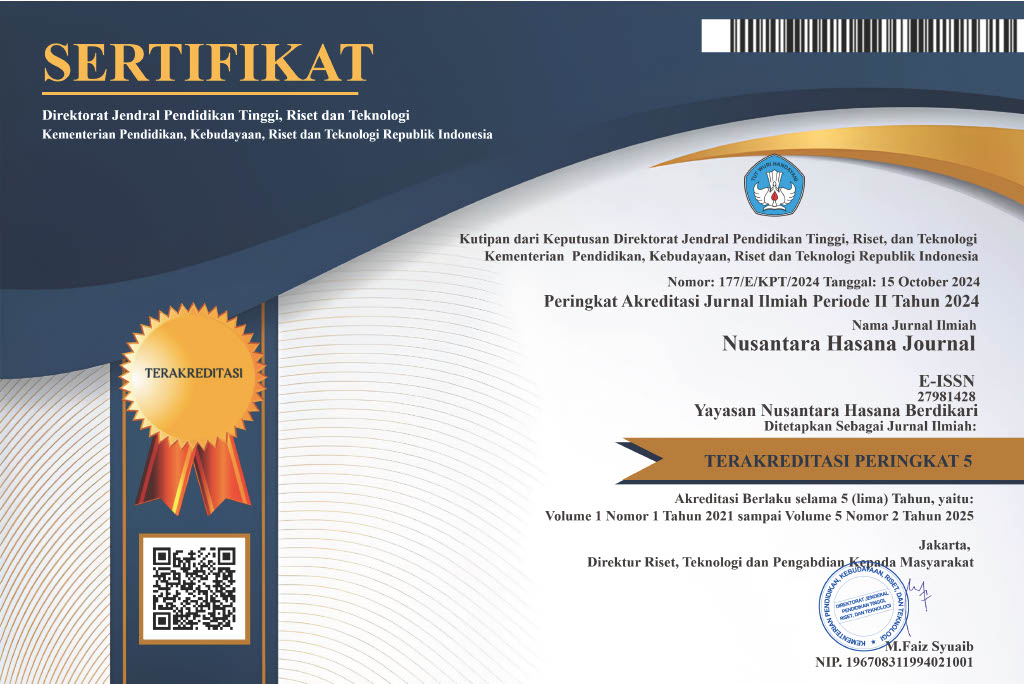SENSORY EVALUATION OF PUKIS ENRICHED WITH DIFFERENT LEVELS OF CARROT PUREE (DAUCUS CAROTA L)
DOI:
https://doi.org/10.59003/nhj.v4i12.1415Keywords:
Carrot puree, Organoleptic evaluation, Pukis, Sensory attributeAbstract
This study investigates the effects of incorporating varying concentrations of carrot puree (0%, 25%, 50%, and 75%) into pukis, a traditional Indonesian snack, on its organoleptic properties. The objective is to enhance the nutritional value of pukis without compromising its sensory attributes, such as color, aroma, texture, taste, and overall acceptability. A hedonic test was conducted to assess consumer preferences for the different formulations. The results indicated that the addition of carrot puree significantly influenced the color, with higher concentrations resulting in a more vibrant orange hue. Aroma and taste were also affected, with the 25% carrot puree formulation being most preferred for maintaining the traditional flavor while offering enhanced sweetness. Texture analysis showed that the 50% carrot puree formulation provided a desirable balance between moisture retention and the light, spongy texture typical of pukis. Overall, the study found that a moderate level of carrot puree (25% to 50%) successfully enhanced the nutritional profile of pukis while preserving its sensory qualities. These findings suggest that carrot puree can be a viable ingredient for fortifying traditional snacks, offering a healthier alternative without compromising consumer acceptance.
Downloads
References
Akesowan, A., & Chareonkul, A. (2024). Effects of partial coconut flour fortification and butter reduction with pumpkin puree in rice donuts. Food Research, 8(4), 61–67. https://doi.org/10.26656/fr.2017.8(4).393
Ali, R. F. M., El-Anany, A., Almujaydil, M. S., ALgheshairy, R. M., Alhomaid, R. M., & Alharbi, H. F. (2025). Nutritional characteristics and sensory aspects of pan bread fortified with different quantities of Chlorella vulgaris powder. Food Chemistry Advances, 6(February), 100940. https://doi.org/10.1016/j.focha.2025.100940
Fadillah, U., Dirpan, A., & Syarifuddin, A. (2024). Fat replacers in food system: A focus on ingredients, fabrication methods, and applications in food products. Future Foods, 10(June). https://doi.org/10.1016/j.fufo.2024.100490
Fiorentini, M., Kinchla, A. J., & Nolden, A. A. (2020). Role of Sensory Evaluation in Consumer Acceptance of Plant-Based Meat Analogs and Meat Extenders: A Scoping Review. Foods, 9(9). https://doi.org/10.3390/foods9091334
Gómez, M., & Martinez, M. M. (2018). Fruit and vegetable by-products as novel ingredients to improve the nutritional quality of baked goods. Critical Reviews in Food Science and Nutrition, 58(13), 2119–2135. https://doi.org/10.1080/10408398.2017.1305946
Guiné, R. P. F. (2022). Textural Properties of Bakery Products: A Review of Instrumental and Sensory Evaluation Studies. Applied Sciences (Switzerland), 12(17). https://doi.org/10.3390/app12178628
Harling, H. (2017). Exploring the Nutritional Value of Carrots and Determining Attributes that are Favored by Consumers [University of Maine]. https://digitalcommons.library.umaine.edu/cgi/viewcontent.cgi?article=1457&context=honors
Hoppu, U., Puputti, S., & Sandell, M. (2021). Factors related to sensory properties and consumer acceptance of vegetables. Critical Reviews in Food Science and Nutrition, 61(10), 1751–1761. https://doi.org/10.1080/10408398.2020.1767034
Ikram, A., Rasheed, A., Ahmad Khan, A., Khan, R., Ahmad, M., Bashir, R., & Hassan Mohamed, M. (2024). Exploring the health benefits and utility of carrots and carrot pomace: a systematic review. International Journal of Food Properties, 27(1), 180–193. https://doi.org/10.1080/10942912.2023.2301569
Karki, R., Ojha, P., Man, D., Dongol, S., Maharjan, S., Mahandhar, U., & Maharjan, S. (2024). Food Fortification : Global Experience , Importance , Challenges and Potential in Nepal Food Fortification : Global Experience , Importance , Challenges and Potential in Nepal. Journal Food Sci Technology Nepa;, 14(October), 1–21. https://doi.org/10.3126/jfstn.v14i14.71713
Martorell, R., & de Romaña, D. L. (2017). Components of Successful Staple Food Fortification Programs: Lessons From Latin America. Food and Nutrition Bulletin, 38(3), 384–404. https://doi.org/10.1177/0379572117707890
Olson, R., Gavin-Smith, B., Ferraboschi, C., & Kraemer, K. (2021). Food fortification: The advantages, disadvantages and lessons from sight and life programs. Nutrients, 13(4). https://doi.org/10.3390/nu13041118
Pedersen, L., Bertelsen, A. S., Byrne, D. V., & Kidmose, U. (2023). Sensory Interactions between Sweetness and Fat in a Chocolate Milk Beverage. Foods, 12(3), 1–14.
Peris, M., Rubio-Arraez, S., Castelló, M. L., & Ortolá, M. D. (2019). From the laboratory to the kitchen: New alternatives to healthier bakery products. Foods, 8(12), 1–27. https://doi.org/10.3390/foods8120660
Petka, K., & Topolska, K. (2025). Vegetable-Enriched Brownies: A Healthier Twist on a Classic Treat. Nutrients , 17(1). https://doi.org/10.3390/nu17010184
Prerana, S., & Anupama, D. (2020). Influence of carrot puree incorporation on quality characteristics of instant noodles. Journal of Food Process Engineering, 43(3). https://doi.org/10.1111/jfpe.13270
Purkiewicz, A., Gul, F. H., & Pietrzak-Fiećko, R. (2024). The Utilization of Vegetable Powders for Bread Enrichment—The Effect on the Content of Selected Minerals, Total Phenolic and Flavonoid Content, and the Coverage of Daily Requirements in the Human Diet. Applied Sciences (Switzerland), 14(21). https://doi.org/10.3390/app142110022
Ranasinghe, M., Manikas, I., Maqsood, S., & Stathopoulos, C. (2022). Date Components as Promising Plant-Based Materials to Be Incorporated into Baked Goods—A Review. Sustainability (Switzerland), 14(2), 1–29. https://doi.org/10.3390/su14020605
Richards, J., Lammert, A., Madden, J., Cahn, A., Kang, I., & Amin, S. (2024). Addition of Carrot Pomace to Enhance the Physical, Sensory, and Functional Properties of Beef Patties. Foods, 13(23), 1–17. https://doi.org/10.3390/foods13233910
Saini, A., Hamid, Shams, R., Dash, K. K., Mukarram Shaikh, A., & Kovács, B. (2025). Anthocyanin extraction from black carrot: Health promoting properties and potential applications. Journal of Agriculture and Food Research, 19(July 2024). https://doi.org/10.1016/j.jafr.2024.101533
van Stokkom, V. L., Poelman, A. A. M., de Graaf, C., van Kooten, O., & Stieger, M. (2018). Sweetness but not sourness enhancement increases acceptance of cucumber and green capsicum purees in children. Appetite, 131(April), 100–107. https://doi.org/10.1016/j.appet.2018.08.034
Vermeir, I., & Roose, G. (2020). Visual design cues impacting food choice: a review and future research agenda. Foods, 9(10), 1–60. https://doi.org/10.3390/foods9101495
Vignesh, A., Amal, T. C., Sarvalingam, A., & Vasanth, K. (2024). A review on the influence of nutraceuticals and functional foods on health. Food Chemistry Advances, 5(May), 100749. https://doi.org/10.1016/j.focha.2024.100749
Wijaya, S. (2019). Indonesian food culture mapping: A starter contribution to promote Indonesian culinary tourism. Journal of Ethnic Foods, 6(1), 1–10. https://doi.org/10.1186/s42779-019-0009-3
Downloads
Published
How to Cite
Issue
Section
License
Copyright (c) 2025 Ratnawati T

This work is licensed under a Creative Commons Attribution-NonCommercial-ShareAlike 4.0 International License.
NHJ is licensed under a Creative Commons Attribution-NonCommercial-ShareAlike 4.0 International License.
Articles in this journal are Open Access articles published under the Creative Commons CC BY-NC-SA License This license permits use, distribution and reproduction in any medium for non-commercial purposes only, provided the original work and source is properly cited.
Any derivative of the original must be distributed under the same license as the original.
























